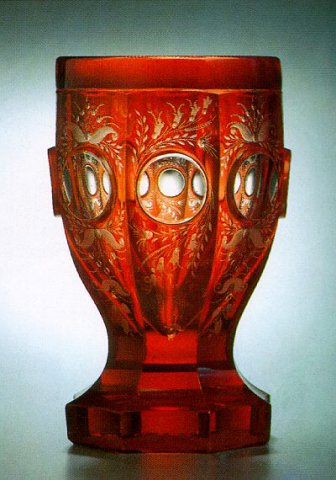At the end of the second world war, Roubíček and other artists moved to the north to help regenerate the glassmaking industry. He, Stanislav Libenský, Václav Cigler and Vladimír Kopecký would shape the glass art tradition not just by creating but by teaching at vocational schools and Prague’s universities.
In 1948, the Communist party, aided by the Soviet Union, seized power in a coup d’état. Private enterprise was banned. Fine artists had to embrace socialist realism: as Landau puts it, “to paint the burly worker with big muscles toiling on the land for the people”. As a result, many migrated to the glass factories, where, while officially designing ashtrays and other useful items, they were able to continue experimenting.
Glass became “the only medium possible under communism”, says Landau. But artists did not make money from their work: it all belonged to the state.
An accomplished jazz pianist, Roubíček used to “improvise in front of the kiln”, says Petrová. On one of the line drawings shown next to his sculptures he wrote “sklo je jazz” — “glass is jazz”. A collection of elongated “Clarinets” (1985-2000) in bright colours evokes the “blowing” that is involved both in making the works and in playing music.
Artists like Roubíček “represented the country very well abroad” in world fairs such as Expo 1958 in Brussels; another reason the regime tolerated them, albeit suspiciously. His wife, Miluše Roubíčková, was an early feminist artist. Her colourful cakes, fruit and flowers, sculpted in hot glass, are expressions of the daily lives of women in the 1960s.
Art historian Sylva Petrová, who lived through communism, finds it difficult to understand. “It doesn’t have any logic,” she says. “It really was absurd.” Petrová is a curator at the Museum of Decorative Arts (UPM) in Prague. Since 1985, she has devoted her career to charting one of the most unexpected stories from Czechoslovakia’s 41 years behind the Iron Curtain: the creation of an autonomous tradition of fine art in glass. The designers working at the time took glass beyond the decorative or functional, and used it as a medium of art.
Achievements in this field are the subject of a new exhibition at the Le Stanze del Vetro, Venice, an exhibition centre founded by the art historian and philanthropist David Landau. Bohemian Glass: The Great Masters introduces six pioneers of Czech glass art to an international audience. Petrová is co-curating the exhibition with Caterina Tognon, a gallery owner based in Venice who has a private collection of about 1,000 pieces of glass. “I am mad, honestly,” she says.
Out of more than 150 exhibits, Tognon estimates that around 80 come from her collection, while 40 — including 19 photographs taken at an exhibition of Czech glass in Prague in 1970 by Josef Sudek — come from UPM. The rest are on loan from the artists’ estates. Tognon stresses that the show is less about “Bohemian glass” in general than the individual artists, their techniques, personalities and ideas. Together, they represent the variety of the Czech tradition.
In contrast, Kopecký used glass as a raw material in his large-scale, mixed-media installations. One of his newest works in the show is “Desire” (2021), a 3.5-metre-long composition of glass panes spattered with red, yellow and blue paint and balanced against the base of a trestle table; over the top he has draped some electric cables. He set out to make what he called “ugly glass”, says Petrová, because “he wanted to express that his idea . . . is more important than the beauty”.
For Libenský and Jaroslava Brychtová, love and art were two sides of the same coin. The relationship began in 1955, when Brychtová asked Libenský if she could cast one of his sketches in glass. Between then and Libenský’s death they produced some of Czechoslovakia’s most significant modern art, including two windows for St Vitus Cathedral in Prague Castle. Their second work together was “Head” (1957-58), a column of dark green glass with an elongated visage cast underneath the surface, which reflects light from within as only a transparent medium can do
Compared with painting, explains Tognon, glass is “a much more difficult medium to use”. This is one reason why its abstract turn only began in earnest in the 1960s. One artist to take abstraction to extremes was Cigler (b 1929), the founder of sculpture in very pure optical glass. Essential to his approach was the final “cold-working” phase, in which his mathematically precise forms — spirals, pyramids, architectural blocks — were cut and polished to prismatic clarity.
Perhaps his most iconic sculptural form was the egg. “Sphere (Rainbow Egg)” (2019), was cast whole and then cut in half, allowing a fine layer of copper powder to be applied to the cross-section before the halves were glued back together. The copper breaks up and distorts the light, so that the object’s colour changes with the position of the viewer. “Nobody is able to be so simple and so complex at the same time,” says Tognon.
Kopecký, who is 91, has recently been in hospital, but is, according to Petrová, determined to create a new artwork at the exhibition opening. When he told his doctors this, they were “a little bit shocked”. But then, says Petrová, “he’s living through art. And actually all of them . . . lived art.”
“Bohemian Glass: The Great Masters”, until November 26; lestanzedelvetro.org
Recommended
Czech Glass is jazz’: finding artistic freedom behind the Iron Curtain

